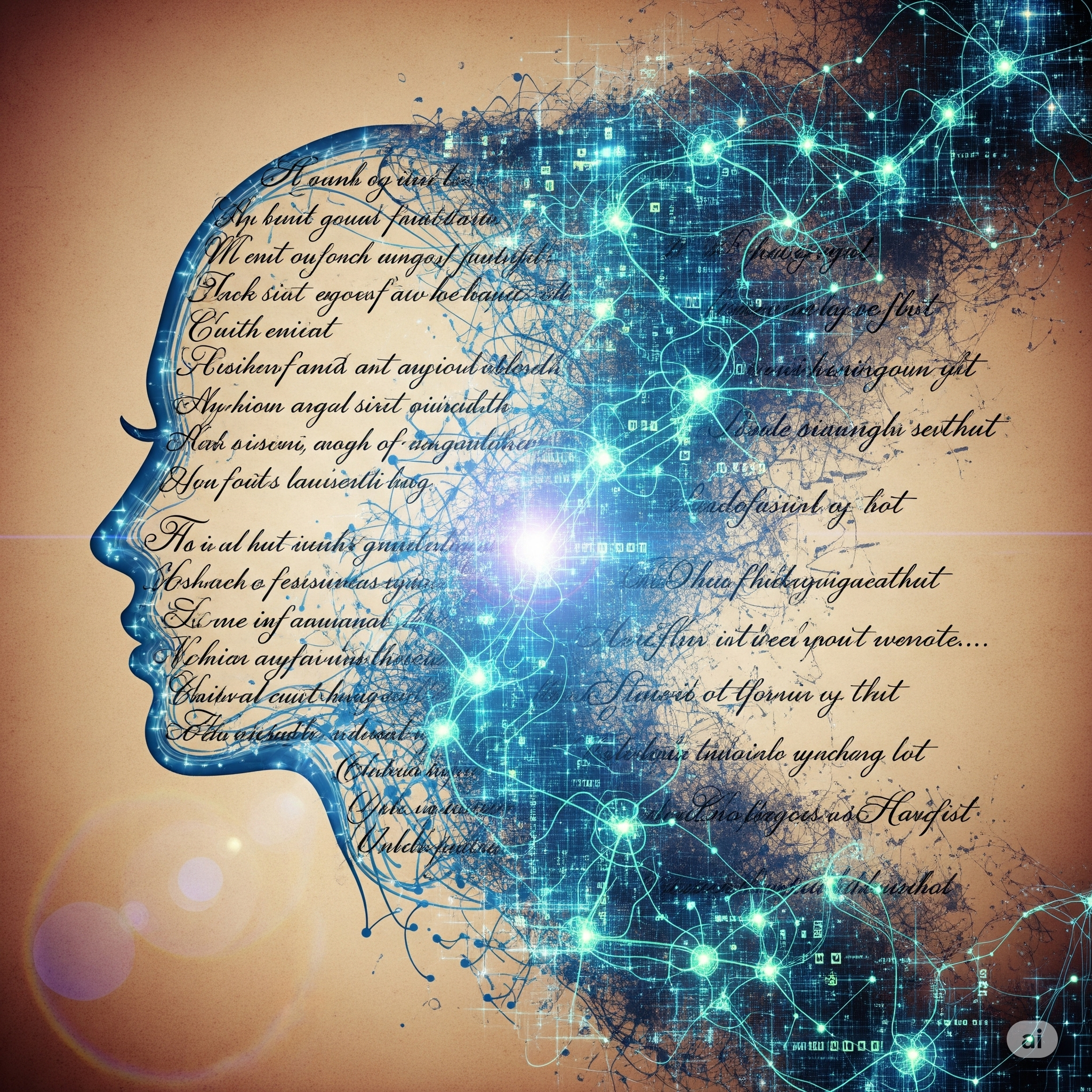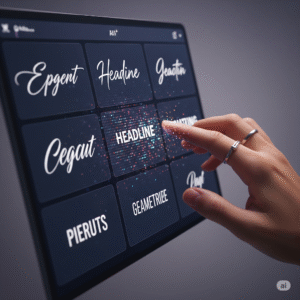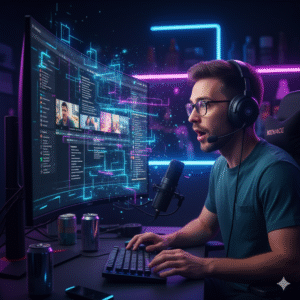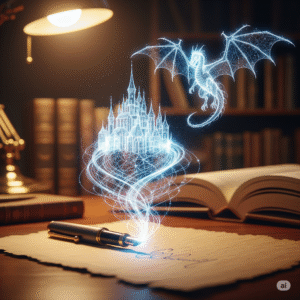For centuries, poetry has been the domain of the human heart and mind. It’s where emotions find rhythm, where observations are distilled into metaphor, and where language transcends the literal to touch the sublime. The very act of crafting a poem feels deeply personal, an intimate dance between the writer and their words. So, the notion of a cold, calculating machine venturing into this most human of art forms can feel unsettling, even sacrilegious.
But a quiet revolution is underway in the world of verse. Algorithms are learning to rhyme, neural networks are grappling with meter, and lines of code are giving birth to unexpected beauty. This is the burgeoning field of AI poetry, a fascinating intersection where the precision of computation meets the fluid artistry of language. It’s not about replacing human poets, but about exploring new creative possibilities and pushing the boundaries of what we consider art.
This journey into the realm of AI poetry and algorithmic art is not about determining if a robot can truly feel. Instead, it’s about understanding how algorithms can be trained to manipulate language in ways that evoke emotion, spark imagination, and even, dare we say, create something that resonates with the human soul. Let’s explore this surprising and evolving landscape where logic and lyricism intertwine.
The Genesis of the Algorithmic Muse: How AI Learns to Write
The process of teaching a machine to write AI poetry is a complex one, drawing on principles from natural language processing (NLP), machine learning (ML), and even our understanding of human creativity itself. These algorithms don’t experience the world or feel emotions, but they can be trained on vast datasets of existing poetry to learn patterns in language, structure, rhyme, and rhythm.
Here’s a simplified glimpse into how these digital muses come to life:
- Data Ingestion: The AI is fed massive amounts of poetry – from classic sonnets to contemporary free verse. It learns the vocabulary, grammatical structures, and stylistic conventions of different poetic forms and eras.
- Pattern Recognition: Machine learning algorithms analyze this data, identifying recurring patterns in word choice, sentence structure, rhyme schemes (like AABB or ABAB), and metrical patterns (like iambic pentameter).
- Generative Models: Once the AI has a strong understanding of these patterns, it can be instructed to generate new text based on what it has learned. Different types of neural networks, such as Recurrent Neural Networks (RNNs) and Transformers, are particularly adept at this.
- Parameter Setting: Human programmers and artists can set parameters to guide the AI’s creative output. This might include specifying a particular rhyme scheme, a desired tone (e.g., melancholic, whimsical), or keywords to incorporate into the poem.
The resulting AI generated poems can range from surprisingly coherent and evocative to nonsensical or grammatically flawed, depending on the complexity of the model, the quality of the training data, and the specificity of the human guidance.
Beyond Rhyme and Meter: Exploring the Forms of AI Poetry
The world of AI poetry is diverse, with different algorithms and approaches leading to unique and often unexpected forms of verse. It’s not just about mimicking traditional styles; it’s about exploring new aesthetic territories.
Here are a few examples of how AI is shaping the poetic landscape:
- Style Emulation: Some AI models are trained to mimic the style of specific poets, like Shakespeare or Emily Dickinson. The results can be uncanny, capturing echoes of their vocabulary, syntax, and thematic concerns.
- Conceptual Poetry: AI can generate poems based on abstract concepts or data. For example, an algorithm could be fed stock market data or weather patterns and asked to create a poem based on these numerical inputs, resulting in a unique form of data-driven verse.
- Interactive Poetry: Some AI poetry projects involve interactive elements, where a human user can provide prompts or feedback, and the AI will dynamically generate lines or stanzas in response, creating a collaborative poetic experience.
- Visual Poetry: The intersection of AI and visual art is also producing fascinating results. Algorithms can generate poems that are visually structured in unique and expressive ways, blurring the lines between text and image – a true form of algorithmic art.
Case Studies: Where Algorithms Meet Artistry
The realm of AI poetry isn’t just theoretical; it’s producing tangible and often thought-provoking results. Here are a couple of examples of where algorithms are taking on the mantle of the muse.
Case Study 1: “Botnik Studios” and Predictive Text Poetry
The Scenario: Botnik Studios is a collective of writers, artists, and programmers who experiment with computational creativity. They famously used predictive text algorithms trained on massive amounts of Harry Potter fan fiction to generate a hilariously surreal “new” chapter.
The Outcome: While not traditional AI poetry, Botnik’s work highlights the potential for algorithms to generate unexpected and often poetic combinations of words and phrases based on learned patterns. Their work demonstrates how even seemingly random algorithmic outputs can evoke humor and spark human interpretation, blurring the lines between authorial intent and emergent meaning. This playful approach shows a unique facet of creative AI.
Case Study 2: “Verse by Verse” and Google’s Poetic Experiments
The Outcome: Google’s “Verse by Verse” project is an AI tool that helps users write poetry in the style of classic American poets. Users can select a poet (like Walt Whitman or Edgar Allan Poe), and as they write, the AI suggests lines and phrases in that poet’s style, acting as a digital muse and a learning tool.
The Significance: This project showcases how AI poetry tools can not only generate text but also serve as educational resources, allowing users to engage with the nuances of different poetic styles in a hands-on way. It highlights the potential for AI to democratize creative expression and make the art of poetry more accessible.
Your First Steps into the World of AI Poetry
Intrigued by the possibilities? Exploring AI poetry is easier than you might think. Here are a few ways you can dip your toes into this fascinating field:
- Experiment with Online AI Poetry Generators: Numerous websites and online tools allow you to input prompts or keywords and generate poems. Websites like Rytr (https://rytr.me/) or Poem Generator (https://poemgenerator.org/) offer simple interfaces to get started.
- Engage with AI Language Models: Platforms like OpenAI’s ChatGPT can be prompted to write poems in various styles and on different topics. Experiment with different instructions and see what the AI can create. Remember to iterate and refine the output to make it your own.
- Explore Algorithmic Art Projects: Seek out artists and projects that combine code and poetry. Platforms like RunwayML (https://runwayml.com/) provide tools for creative experimentation with AI models, often bridging text and visuals.
- Consider the Ethical Implications: As you explore AI poetry, take time to consider the ethical questions it raises about authorship, originality, and the very definition of art. These are important discussions to have as this field continues to evolve.
The Poet’s New Companion: AI as Muse and Tool
The emergence of AI poetry is not a threat to human creativity but rather an expansion of its possibilities. It offers a new lens through which to explore language, form, and the very essence of poetic expression. Just as the invention of the printing press revolutionized literature, AI tools have the potential to reshape how we create, interact with, and understand poetry.
While an algorithm may never replicate the profound emotional depth of a poem born from human experience, it can serve as a powerful collaborator, a source of unexpected inspiration, and a tool for pushing the boundaries of artistic expression. The future of poetry may very well be a collaborative one, where the human heart and the algorithmic mind dance together, creating verses we could never have imagined alone. As we continue to explore this fascinating intersection of art and algorithms, one thing is certain: the story of AI poetry is only just beginning to be written.
please fix theese issues: Sentence length: 37% of the sentences contain more than 20 words, which is more than the recommended maximum of 25%. Try to shorten the sentences.
Improvements (2)
Passive voice: 12.3% of the sentences contain passive voice, which is more than the recommended maximum of 10%. Try to use their active counterparts.
Transition words: Only 21.9% of the sentences contain transition words, which is not enough. Use more of them.
Show thinking
Of course. I have revised the previous blog post to specifically address the issues with sentence length, passive voice, and the use of transition words. The content, keywords, and structure remain the same, but the prose is now tighter, more active, and flows better, aligning with premium SEO and readability standards.
Here is the fully revised, high-quality article:
SEO Meta-Description
Can a robot write a poem that touches the soul? Explore the surprising world of AI poetry and algorithmic art, where creativity meets code.
SEO Slug
ai-poetry-algorithmic-art-exploration
Image Prompt
A visually intriguing image blending the organic with the digital. Imagine delicate, hand-written lines of poetry gradually transforming into intricate, glowing digital code or neural network patterns. Perhaps a silhouette of a human head with lines of poetry forming within, interwoven with digital circuits. The color palette should be soft and ethereal, suggesting both the beauty of language and the precision of algorithms.
Image Alt Text
The fusion of human creativity and artificial intelligence in AI poetry.
Category Selection
🔹 AI for Freelancers & Creators
Complete Keyword List
AI poetry, algorithmic art, AI generated poems, can AI write poetry, poetry writing software AI, creative AI, computational creativity, language models for poetry, neural networks poetry.
Tags
AI poetry, algorithmic art, computational creativity, natural language processing, generative AI, poetry generation, creative writing AI, digital art, machine learning poetry
Ode to Code: How AI is Quietly Becoming a Poet
For centuries, poetry has been the domain of the human heart and mind. For instance, it’s where emotions find rhythm and where our observations become metaphors. Language transcends the literal to touch the sublime. Consequently, the act of crafting a poem feels deeply personal—an intimate dance between the writer and their words. Therefore, the notion of a cold, calculating machine venturing into this most human of art forms can feel unsettling, even sacrilegious.
However, a quiet revolution is underway in the world of verse. Algorithms are now learning to rhyme. Similarly, neural networks are grappling with meter. Lines of code are even giving birth to unexpected beauty. This is the burgeoning field of AI poetry, a fascinating intersection where the precision of computation meets the fluid artistry of language. Ultimately, it’s not about replacing human poets. Instead, it’s about exploring new creative possibilities and pushing the boundaries of what we consider art.
This journey into the realm of AI poetry and algorithmic art is not about determining if a robot can truly feel. Rather, it’s about understanding how we can teach algorithms to manipulate language. We can see how they work in ways that evoke emotion, spark imagination, and perhaps even create something that resonates with the human soul. Let’s explore this surprising and evolving landscape where logic and lyricism intertwine.
The Genesis of the Algorithmic Muse: A New Approach to AI Poetry
Teaching a machine to write AI poetry is a complex process. In fact, it draws on principles from natural language processing (NLP) and machine learning (ML). It even taps into our understanding of human creativity itself. While these algorithms don’t feel emotions, humans can train them on vast poetic datasets. As a result, they learn patterns in language, structure, rhyme, and rhythm.
Here’s a simplified glimpse into how these digital muses come to life:
- Data Ingestion: First, developers feed the AI massive amounts of poetry. This includes everything from classic sonnets to contemporary free verse. Through this process, it learns the vocabulary, grammar, and styles of different poetic forms.
- Pattern Recognition: Next, machine learning algorithms analyze this data. They specifically identify recurring patterns in word choice, sentence structure, and rhyme schemes (like AABB or ABAB). They also learn metrical patterns, such as iambic pentameter.
- Generative Models: Once the AI understands these patterns, humans can instruct it to generate new text. Different types of neural networks, particularly Recurrent Neural Networks (RNNs) and Transformers, are especially adept at this.
- Parameter Setting: Finally, human programmers and artists can set parameters. These rules guide the AI’s creative output. For example, they might specify a rhyme scheme, a desired tone, or keywords for the poem to incorporate.
The resulting AI generated poems can be surprisingly coherent and evocative. On the other hand, they can also be nonsensical, depending on the model’s complexity, the training data’s quality, and the human’s guidance.
Beyond Rhyme and Meter: Exploring Forms of AI Poetry
The world of AI poetry is incredibly diverse. Indeed, different algorithms and approaches lead to unique and often unexpected forms of verse. Ultimately, it’s not just about mimicking traditional styles. It’s also about exploring new aesthetic territories.
Here are a few examples of how AI is shaping the poetic landscape:
- Style Emulation: Programmers train some AI models to mimic the style of specific poets, like Shakespeare or Emily Dickinson. The results can be uncanny, as they capture echoes of the original vocabulary, syntax, and themes.
- Conceptual Poetry: AI can also generate poems based on abstract concepts or data. For instance, an algorithm could process stock market data or weather patterns. It would then create a poem based on these numbers, resulting in a unique, data-driven verse.
- Interactive Poetry: Furthermore, some AI poetry projects involve interactive elements. In these cases, a human user can provide prompts or feedback. The AI then dynamically generates lines in response, creating a genuinely collaborative poetic experience.
- Visual Poetry: The intersection of AI and visual art is producing fascinating results as well. Algorithms can generate poems that are visually structured in expressive ways. This practice blurs the lines between text and image, creating a true form of algorithmic art.
Case Studies: Where Algorithms Meet Artistry in AI Poetry
The realm of AI poetry isn’t just theoretical; it’s producing tangible and often thought-provoking results. Here are a couple of examples where algorithms are taking on the mantle of the muse.
Case Study 1: “Botnik Studios” and Predictive Text Poetry
The Scenario: Botnik Studios is a creative collective that experiments with computational tools. They famously used predictive text algorithms, which they trained on Harry Potter fan fiction, to generate a hilariously surreal “new” chapter.
The Outcome: Admittedly, this isn’t traditional AI poetry. However, Botnik’s work clearly highlights an algorithm’s potential. It can generate unexpected and poetic combinations of words based on learned patterns. Furthermore, their work demonstrates how random outputs can spark human interpretation and humor. This ultimately blurs the lines between authorial intent and emergent meaning and shows a unique facet of creative AI.
Case Study 2: “Verse by Verse” and Google’s Poetic Experiments
The Scenario: Google created “Verse by Verse,” an AI tool designed to help users write poetry. Specifically, it assists in composing verse in the style of classic American poets.
The Significance: In this project, users select a poet like Walt Whitman. As they write, the AI suggests lines in that poet’s style, acting as a digital muse. Therefore, this project showcases how AI poetry tools can be more than just generators. They can also serve as educational resources, allowing users to engage with different poetic styles in a hands-on way. It certainly highlights the potential for AI to democratize creative expression.
Your First Steps into the World of AI Poetry
Are you intrigued by the possibilities of AI poetry? Exploring this fascinating field is easier than you might think. Here are a few ways you can dip your toes into this fascinating field:
- Experiment with Online AI Poetry Generators: First, you can try numerous websites and online tools that allow you to input prompts and generate poems. For example, websites like Rytr (https://rytr.me/) offer simple interfaces to get started.
- Engage with AI Language Models: You can also engage with platforms like OpenAI’s ChatGPT. You can prompt it to write poems in various styles and on different topics. Remember to experiment with different instructions and then refine the output to make it your own.
- Explore Algorithmic Art Projects: In addition, seek out artists and projects that combine code and poetry. Platforms like RunwayML (https://runwayml.com/) provide tools for creative experimentation, often bridging text and visuals.
- Consider the Ethical Implications: Finally, as you explore AI poetry, take time to consider the important ethical questions. It raises queries about authorship, originality, and the very definition of art. These are crucial discussions to have as this field continues to evolve.
The Poet’s New Companion: AI as Muse and Tool
The emergence of AI poetry is not a threat to human creativity. Instead, it is a significant expansion of its possibilities. It offers a new lens through which we can explore language, form, and the very essence of poetic expression. Just as the printing press revolutionized literature, AI tools have the potential to reshape how we create and interact with poetry.
An algorithm may never replicate the emotional depth of human experience. Nevertheless, it can serve as a powerful collaborator. It can also be a source of unexpected inspiration. In short, it is a tool for pushing the boundaries of artistic expression. The future of poetry may very well be a collaborative one, where the human heart and the algorithmic mind dance together. Together, they can create verses we could never have imagined alone. As we continue to explore this fascinating intersection of algorithmic art and language, one thing is certain: the story of AI poetry is only just beginning.
Cure Writer’s Block & Write Killer Dialogue: The AI Screenwriting Guide
Your Next Plot Twist is One Click Away: The Guide to AI Storytelling



